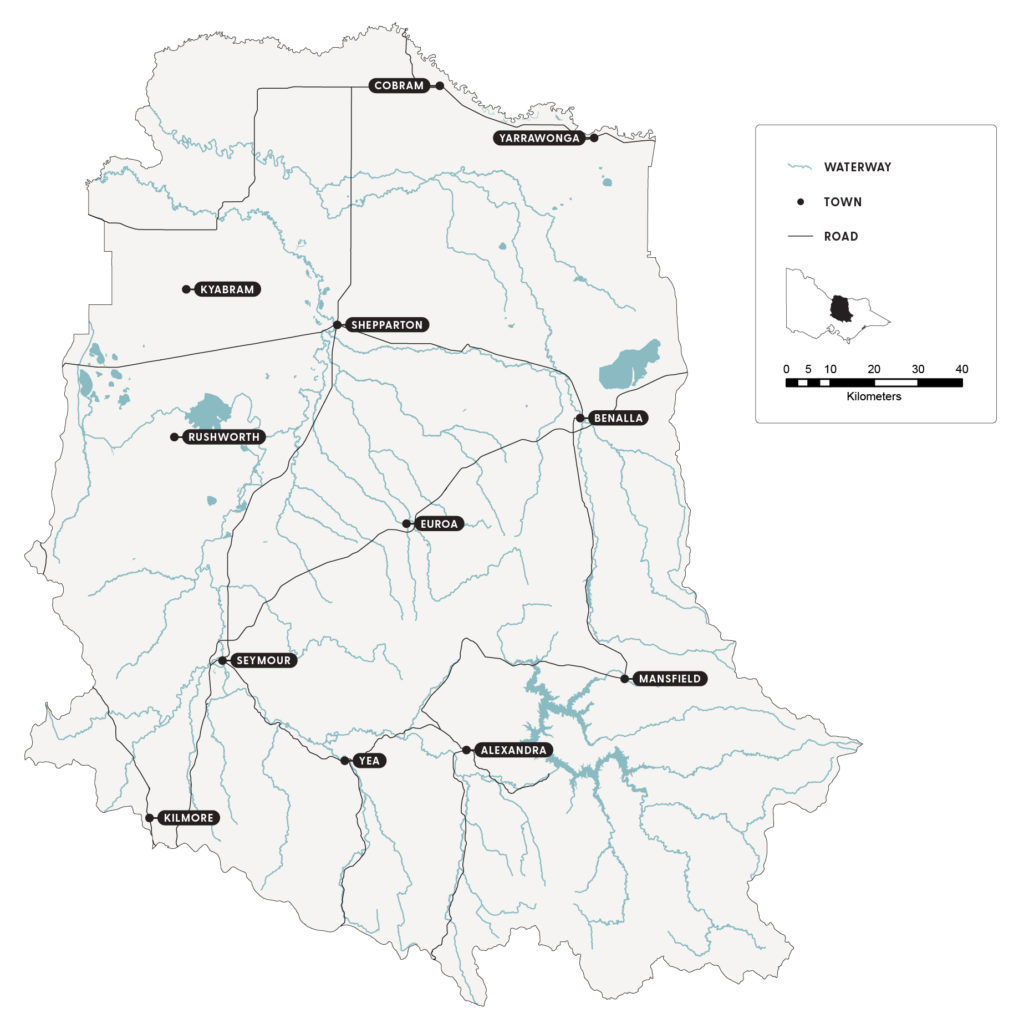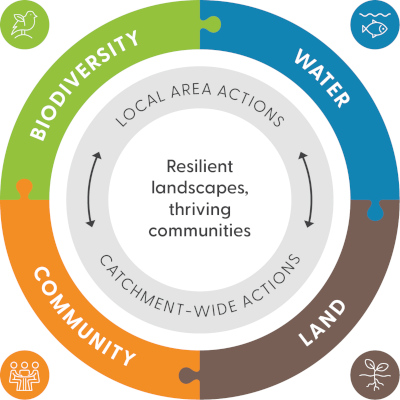Welcome to the Goulburn Broken Regional Catchment Strategy

The Goulburn Broken Catchment is situated in Victoria and is part of the Murray-Darling Basin. It encompasses the valleys of the Goulburn and Broken rivers and part of the Murray Valley, covering 10.5% of Victoria. The catchment stretches from close to the outskirts of greater Melbourne in the south, to the Murray River in the north, Mt Buller to the east and the Mt Camel Range to the west, as shown in Figure 1.
A catchment is an area where water is collected by the natural landscape. Water flows from the highest point, usually mountains and hills, to a low point, such as a dam, location on a river or the mouth of a river.
The catchment includes two Registered Aboriginal Parties representing the interests of Traditional Owners for their respective Country: Yorta Yorta Nation Aboriginal Corporation (YYNAC) and Taungurung Land and Waters Council (TLaWC). This includes active involvement in natural resource management (NRM) through joint management agreements and legislative rights to public land.
The Goulburn Broken Regional Catchment Strategy (the strategy) is a vision for the integrated management of natural resources in the catchment. It is a blueprint for improving catchment health and builds on achievements and lessons from the past. The strategy describes the current condition of the natural resources, principles to guide change, priority actions and what success looks like in 2040.
It is an ambitious strategy and describes the urgent and large-scale change required to improve the catchment’s natural resources and mitigate climate change. In addition to current activities and investment, we will need to find alternative ways of doing things and new investment sources to achieve the outcomes of the strategy.
The strategy is for all organisations, groups and individuals contributing to the catchment’s NRM. We all have an important role to play to reverse the declining health of the catchment’s land, water and biodiversity. The Goulburn Broken Catchment Management Authority (CMA) is responsible for coordinating the strategy.
A resilience approach underpins the strategy and focuses on how we can increase the capacity of the catchment to cope with change and evolve positively.
This is the first time the strategy has been presented as a website. A site map and glossary are available to help navigate the content. To access a PDF version of a page or the whole strategy, click on the download button in the top right-hand corner of the website.
Figure 2 provides a summary of the strategy and you can download a PDF version by clicking on the link below.
Information about the different components of the strategy is outlined below.
Current situation
The catchment’s natural resources provide a range of services that people value, including:
- ecosystem, such as clean air, drinking water, community health and wellbeing
- economic, such as agriculture and tourism
- lifestyle, such as beautiful scenery and job opportunities
- recreation, such as fishing, skiing and camping.
The condition of the catchment’s natural resources can be assessed by looking at the themes of biodiversity, community, land and water. The community theme refers to the capacity and resilience of the community and is a focus because community engagement in NRM is a major driver of biodiversity, land and water health.
Qualitative condition ratings for each theme have been reported by the Goulburn Broken CMA since 1990 using available evidence. These ratings have been drawn from Goulburn Broken CMA annual reports, tipping points described by the community, socio-economic research and discussion papers developed as part of the strategy renewal. A snapshot of the current condition and trends for each theme is shown in Table 1.
Natural systems can respond to change in a number of ways or phases. The response phase for each theme is listed in Table 1. The 3 main response phases are:
- Persistence: the system stays the same in the face of change.
- Adaptation: management actions are modified in response to change and the changes endure while the purpose of the system remains the same.
- Transformation: the system fundamentally alters in response to change, where management and the overall purpose of the system changes.
Table 1: A snapshot of the condition of biodiversity, community, land and water in the Goulburn Broken Catchment
| Theme | Current condition | Trend since 2013 | Response phase* | Long-term risk (given current support) |
|---|---|---|---|---|
| Biodiversity | Poor | Declining | Transformation | Very high |
| Community | Satisfactory | Stable | Adaptation and transformation | Medium |
| Land | Satisfactory | Stable | Adaptation | Medium |
| Water | Satisfactory | Declining | Adaptation and transformation | Medium |
Major drivers of change and emerging trends impacting the catchment’s natural resources were identified through community engagement and socio-economic analysis.
Seven major drivers of change were identified:
- climate change
- technological innovation
- transition to a services economy
- ageing population
- increasing and competing priorities for public resources
- increasing role and recognition of Traditional Owners and First Nations People
- water as a tradeable commodity.
Detailed assessment of the current condition, trends and drivers of change for each natural resource theme is found here.
Principles to guide change
Five key principles were identified by stakeholder engagement and guide the renewal and implementation of the strategy:
- Strengthen partnerships: community, landholders and agencies work together to achieve the catchment’s vision.
- Community-led: community leaders are involved in decision making and priority actions align with community values.
- Embed resilience principles: integrate a complex, systems view of the world including accommodating different scales and perspectives, factoring in an uncertain future and knowledge and anticipating and adapting to change.
- Supported by science: priority actions address critical tipping points, improve knowledge and understanding by monitoring, questioning assumptions and experimentation and facilitate partnerships with innovators and researchers.
- Foster stewardship: priority actions build values of environmental stewardship among community, landholders and organisations. Environmental stewardship involves the responsible use and protection of the natural environment through conservation and sustainable practices to enhance ecosystem resilience and human wellbeing.
Priority directions
Priority directions have been developed as part of the strategy renewal to guide investment, collaboration and on-ground activities.
There are 6 overarching, catchment-wide priorities for the next 6 years:
- Reverse the declining health of the catchment’s land, water and biodiversity.
- Implement pathways to adapt and transform in response to drivers of change.
- Give effect to priorities in First Nations Country Plans.
- Continue to build an understanding of tipping points and their role in navigating change.
- Build environmental stewardship values among an increasingly diverse community.
- Broaden investment and contributions to natural resource management.
Priority actions have been developed for local areas and natural resource themes.
What success looks like
Visions have been developed as part of the strategy’s renewal. The visions capture what the diverse communities want the future to look like in 2040.
Catchment vision
Resilient landscapes, thriving communities.
Local area visions
Table 2: Visions for the Goulburn Broken Catchment local areas
| Local area | Vision |
|---|---|
| Agricultural Floodplains | The Agricultural Floodplains community leads Australia in producing food in harmony with the environment. |
| Commuting Hills | The Commuting Hills has a safe, sustainable future and a great quality of life, while protecting and enhancing the wonderful natural environment. |
| Productive Plains | Through strong and supportive community networks, the Productive Plains balances land productivity, quality water access and native vegetation quantity and condition in a changing climate. |
| Southern Forests | With the community, the Southern Forests balances ecological, economic, cultural and recreational needs to preserve natural resource health. |
| Upland Slopes | The Upland Slopes is a climate resilient socio-ecological system, supported by a strong sense of place and pride in our engaged, knowledgeable and adaptive community. |
| Urban Centres | Urban Centres offer employment, facilities and services for residents while valuing the natural environment. |

Theme visions
Table 3: Visions for the Goulburn Brocken Catchment themes
| Theme | Vision |
|---|---|
| Biodiversity | Biodiversity is valued, resilient and flourishing. |
| Community | A motivated and connected community leads positive change for people, land, water and biodiversity. |
| Land | A diverse and productive landscape with healthy, functioning soils. |
| Water | Water resources deliver agreed cultural, environmental, economic and social values now and for future generations. |

Further information
Click on the links below for further information:
Show your support
Pledge your support for the Goulburn Broken Regional Catchment Strategy and its implementation.




